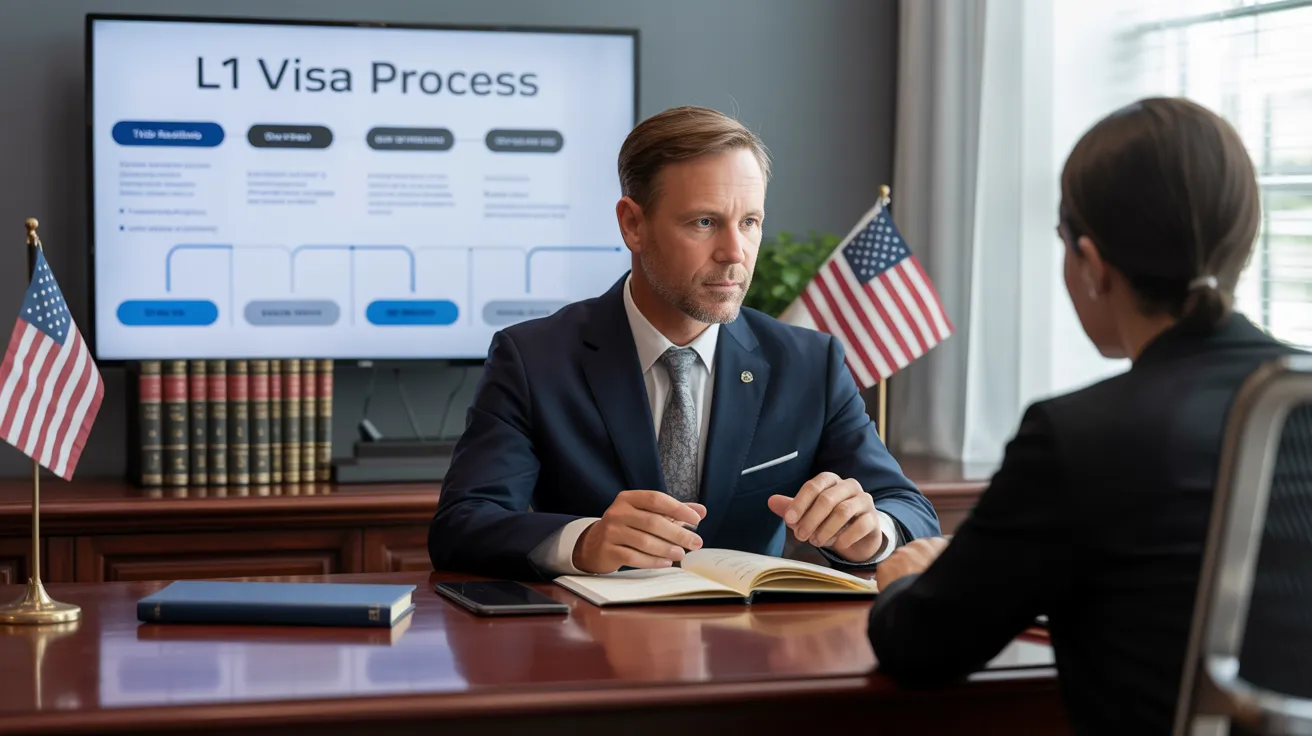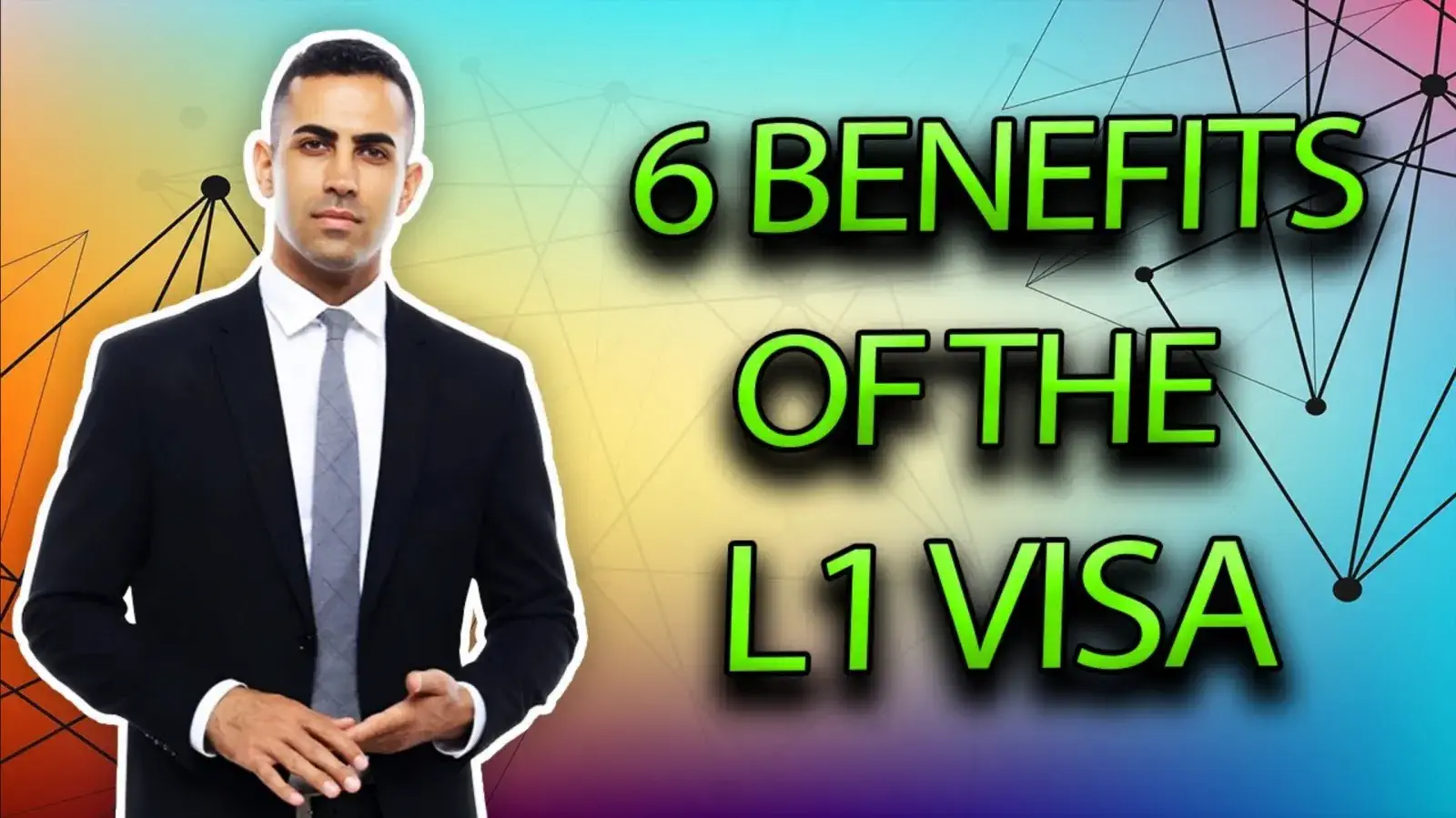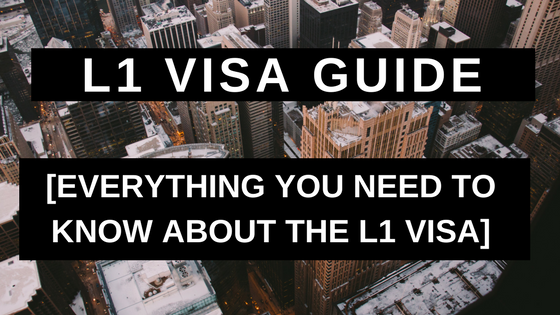Unlocking Opportunities: A Comprehensive Guide to the L1 Visa Process
The L1 visa procedure provides a crucial path for multinational business seeking to move key staff members across borders. Understanding the nuances of qualification standards, the distinctions between L-1A and L-1B visas, and the details of the application process can considerably impact a candidate's success. Nevertheless, navigating this facility landscape is not without its difficulties, and cautious attention to documents and employer sponsorship is crucial. As we check out the crucial components of this process, the approaches for overcoming possible challenges will come to be obvious, disclosing exactly how educated preparation can open a globe of opportunities.
Comprehending the L1 Visa
Understanding the L1 visa entails recognizing its value as a vital tool for international firms seeking to transfer proficient workers in between worldwide workplaces. This non-immigrant visa group promotes the movement of executives, managers, and specialized expertise workers to the United States, therefore making it possible for companies to maintain operational continuity and harness worldwide ability effectively. The L1 visa is separated right into two primary categories: L-1A for supervisors and execs, and L-1B for workers having specialized knowledge.The L1 visa serves an essential function in enhancing a business's affordable side in the international marketplace. By allowing business to relocate their crucial employees, companies can guarantee that important jobs are managed by certified people who are currently acquainted with the firm's culture and operational processes. L1 Visa. This interior transfer device not just cultivates expertise sharing however additionally advertises technology and collaboration across borders.Moreover, the L1 visa is usually preferred for its reasonably straightforward application procedure compared to various other visa groups, as it permits for dual intent, allowing holders to go after irreversible residency while on a momentary copyright. This feature makes the L1 visa specifically appealing for both companies and employees, as it simplifies the path for knowledgeable professionals to establish lasting residency in the USA
Qualification Criteria
Eligibility for the L1 visa rests on numerous essential standards that guarantee both the staff member and the company fulfill certain credentials. This non-immigrant visa is made for multinational companies to transfer workers from consular services to united state counterparts.Firstly, the company has to be a certifying company, which includes a parent firm, branch, associate, or subsidiary of an U.S. organization. The business should have been doing business for a minimum of one year both in the U.S. and abroad. This ensures that the company has sufficient functional security and a genuine presence.Secondly, the employee should hold a managerial, executive, or specialized understanding position. For L1A visas, the candidate has to demonstrate supervisory or executive credentials, while L1B visas focus on specialized knowledge pertaining to the company's products, solutions, or processes. In addition, the employee should have worked for the foreign entity for at the very least one continual year within the last three years prior to their application.Lastly, the staff member's duty in the U.S. should straighten with their previous setting, making certain that their abilities and expertise are leveraged for the firm's benefit.

Kinds of L1 Visas
The L1 visa category comprises two key types created to facilitate the transfer of employees within international business: the L1A visa for managers and execs, and the L1B visa for employees with specialized expertise. Each type serves distinctive objectives and has particular qualification criteria.The L1A visa is customized for individuals who hold managerial or executive placements within a business. This visa makes it possible for high-level employees to transfer to a united state branch, subsidiary, or associate of the exact same company. Applicants for the L1A visa have to show that they have been utilized in a managerial or executive capability for at the very least one constant year within the previous 3 years before their application. Furthermore, this visa supplies a much longer period of stay, at first approved for 3 years, with the opportunity of extensions for approximately 7 years.In contrast, the L1B visa is intended for professionals with specialized understanding pertaining to the company's items, solutions, or processes. To qualify, applicants have to prove that their proficiency is crucial to the company and that they have helped a minimum of one continuous year within the last 3 years in a duty that required this specialized expertise. The L1B visa is initially provided for three years, with expansions readily available for as much as five years.Both visa types are important for firms looking for to boost their international procedures by leveraging knowledgeable workers, thus promoting advancement and efficiency within the U.S. market.
Application Process
Steering through the L1 copyright process entails numerous crucial steps that should be diligently complied with to ensure an effective outcome. The process begins with the U.S. company, that must initially establish eligibility by showing a certifying connection with the international entity and confirming that the worker satisfies the particular demands for the L1 visa group being sought.Once eligibility is confirmed, the company launches the process by submitting Type I-129, the Petition for a Nonimmigrant Employee, with the U.S. Citizenship and Immigration Solutions (USCIS) This form should be gone along with by a thorough description of the task duties to be done, the business structure of both the U.S. and international entities, and the worker's credentials. It's vital to validate that all details is accurate and total, as noninclusions or errors can result in hold-ups or denials.Upon approval of the I-129 request, the following action entails the staff member obtaining the L1 visa at an U.S. embassy or consulate in their home country. This phase needs the completion of Kind DS-160, the Online Nonimmigrant copyright, and arranging an interview. During the interview, the applicant should offer evidence sustaining their credentials and the company's petition.After the visa is provided, the staff member can go into the United States to operate in the designated duty. Generally, mindful prep work and adherence to every action of the application procedure are crucial for an effective L1 visa end result.
Needed Paperwork

Vital Types Needed
Navigating the L1 Visa procedure calls for careful attention to the essential kinds and documents necessary for an effective application. The primary kind needed is the Type I-129, Application for a Nonimmigrant Employee, which must be completed and sent by the U.S. employer (L1 Visa). This type outlines the details of the work deal and the credentials of the staff member seeking the L1 Visa.Alongside Type I-129, the applicant will require to full Kind I-539 if accompanying household members are additionally getting visas. Additionally, the company needs to supply evidence of the qualifying relationship between the united state entity and the foreign entity, typically necessitating the submission of corporate documents such as write-ups of incorporation or financial statements.Moreover, it is necessary to consist of the L Category Supplement to Kind I-129, which defines the type of L Visa being asked for-- either L-1A for managers and executives or L-1B for staff members with specialized knowledge. Applicants need to ensure that all kinds are authorized and dated appropriately, as incomplete submissions can lead to hold-ups or rejections. Correctly setting up these vital forms lays the structure for a smoother L1 copyright process
Sustaining Proof Requirements
Sustaining paperwork is crucial for an effective L1 copyright, as it corroborates the cases made in the petition. Candidates should supply a variety of records to show eligibility for the visa, which is categorized right into two main kinds: proof of the qualifying partnership in between the U.S. and foreign entities and evidence of the applicant's qualifications.To develop the partnership, applicants must send documents such as corporate business graphes, economic statements, and proof of possession. These documents confirm that the international firm has a qualifying partnership with the united state employer, whether as a parent business, subsidiary, branch, or affiliate.For the applicant's certifications, necessary documents include a thorough work letter from the international company, laying out the applicant's work title, obligations, and period of employment. In addition, academic qualifications, such as degrees and diplomas, should be given to prove the applicant's expertise in the appropriate field.
Employer Sponsorship Files
Employer sponsorship records play an important role in the L1 copyright procedure, as they confirm the U.S. employer's dedication to the applicant's employment in the United States. These papers are vital for showing the company's qualification to fund the applicant for the L1 Visa.Key papers normally required include a thorough employment letter from the U.S. company, which describes the job title, responsibilities, and the nature of the work connection. In addition, the employer must give evidence of the company's legitimacy, such as business licenses, income tax return, and business graphes, illustrating the partnership between the U.S. entity and the international company.Furthermore, evidence of the worker's qualifying relationship with the international business is required. This may include documents evidencing the worker's function in the foreign entity, such as pay stubs, employment contracts, or efficiency evaluations.
Usual Obstacles
Steering the L1 visa process provides numerous common challenges that candidates need to recognize (L1 Visa). Key issues frequently consist of rigorous documents requirements, potential hold-ups in handling times, and the need for stringent legal conformity. Comprehending these obstacles can help applicants much better prepare and mitigate risks throughout their copyright journey
Paperwork Requirements
The L1 copyright procedure typically offers significant difficulties associated with paperwork needs. Applicants must provide considerable documentation to establish qualification, which can result in confusion and potential delays. Secret papers consist of evidence of a qualifying connection in between the U.S. and foreign employer, proof of the applicant's work history, and detailed info concerning the job duty in the U.S.One usual obstacle is collecting sufficient proof to demonstrate the nature of the qualifying partnership. Firms typically have a hard time to existing clear organizational graphes or economic declarations that illustrate the link between the entities. Additionally, making sure that letters of support from employers precisely reflect the candidate's task obligations and certifications is essential, as vague descriptions can cause denials.Another problem emerges from the need for detailed task descriptions that align with the L1 visa classifications. Applicants have to verbalize not only their current duty but likewise their supervisory or specific knowledge duties clearly. This necessitates an extensive understanding of both the candidate's setting and the regulatory language used in L1 applications.
Processing Time Hold-ups
Experiencing delays in handling times is a common obstacle encountered by L1 visa candidates, often causing stress and unpredictability. Numerous elements add to these hold-ups, consisting of high application quantities, enhanced examination of applications, and management backlogs within the U.S. Citizenship and Migration Services (USCIS) Candidates may find that processing times can differ substantially relying on the service center handling their application, as each facility has its very own workload and performance degrees. Furthermore, the intricacy of the candidate's instance, such as the requirement for considerable documentation or clarification, can further extend wait times.In some instances, problems connected to the candidate's current immigration status or previous visa history might likewise bring about additional delays, as USCIS may require further review or information. It is necessary for candidates to remain positive during this period, keeping open communication with their companies and legal agents to resolve any prospective issues promptly.Understanding these processing time difficulties can help L1 visa applicants prepare for possible hold-ups and minimize the influence on their shift and profession plans. Persistence and persistance are necessary virtues in navigating this intricate procedure.
Legal Conformity Issues
Lots of L1 visa candidates encounter legal conformity concerns that can complicate their journey towards obtaining the visa. Recognizing and adhering to the specific L1 Visa Lawyer laws established by the united state Citizenship and Migration Services (USCIS) is vital. Usual difficulties include showing the qualifying partnership in between the international and U.S. companies, along with confirming that the applicant possesses the requisite specific knowledge or managerial capacity.Additionally, candidates should give complete documents detailing their work tasks, corporate framework, and financial practicality of the U.S. entity. Poor or incorrect paperwork can lead to delays or perhaps denials. Companies need to likewise guarantee that they adhere to labor legislations, consisting of wage and working condition criteria, which can impact visa eligibility.Another usual problem includes keeping compliance with the regards to the visa when provided. Adjustments in work condition, work duties, or business framework can demand modifications to the visa, which otherwise attended to quickly can bring about legal complications. Consequently, remaining informed concerning compliance requirements and looking for legal counsel when required is vital to browse the complexities of the L1 visa procedure effectively.
Tips for Success
Success in the L1 copyright procedure typically depends upon precise preparation and attention to detail. To boost your chances of approval, begin by completely comprehending the qualification requirements for both the L1A and L1B visa groups. Review whether your position at the company certifies as managerial, executive, or specialized expertise, as this classification especially impacts your application.Next, collect comprehensive documentation that confirms your claims. This includes organizational charts, in-depth task summaries, and evidence of the business's operational framework. Clear and succinct proof of the certifying connection in between the united state entity and the foreign entity is vital. Confirm that all records are organized practically and offered in an expert way, as this shows your commitment and seriousness regarding the application.Engage the services of a knowledgeable immigration lawyer that concentrates on L1 visas. Their competence can confirm vital, leading you with complex laws and guaranteeing that all paperwork abides with existing regulations. Furthermore, prepare for the meeting by exercising solutions to common questions and preparing to review your duty and contributions to the firm detailed.
Regularly Asked Inquiries
Can Household Members Accompany the L1 Visa Owner?
Yes, household members of L1 visa owners, including partners and unmarried kids under 21, can come with the primary visa holder. They might likewise get L2 visas, which permit them to reside in the USA.
How Much Time Can I Remain on an L1 Visa?
The L1 visa allows first keeps of up to 3 years, with the opportunity of expansion. L1A visa holders might remain for an optimum of seven years, while L1B visa holders can continue to be for 5 years.
Can L1 Visa Owners Apply for a Permit?
Yes, L1 visa holders can use for a permit. They might seek irreversible residency through employment-based categories, generally needing sponsorship from their employer, provided they satisfy the needed certifications and paperwork requirements.
What Happens if My L1 copyright Is Rejected?
If your L1 copyright is rejected, you might obtain a notification describing the reasons for rejection. You can look for to appeal the choice, reapply, or explore alternate visa choices based on your conditions.
Exist Any Type Of Travel Constraints With an L1 Visa?
An L1 visa usually enables for international travel; nevertheless, re-entry to the united state is contingent upon maintaining legitimate status. Travelers should ensure compliance with visa conditions to avoid issues upon return
Final thought

Comments on “Apply for L1 Visa”